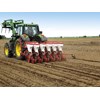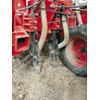Farmchief XACT fodder beet planter review


 The rear press wheels ensure good seed to soil contact
The rear press wheels ensure good seed to soil contact



 Clever alternating marker arms work off one spool valve
Clever alternating marker arms work off one spool valve

 The in-cab controller is minimal but adequate
The in-cab controller is minimal but adequate

 The convenient sight flap
The convenient sight flap

 The marker arm in the transport position
The marker arm in the transport position

 Fertiliser coulters drop the fert in front of seeding discs to provide close nutrients without the risk of seed burn
Fertiliser coulters drop the fert in front of seeding discs to provide close nutrients without the risk of seed burn




|

|
|
The rear press wheels ensure good seed to soil contact
|

|

|
|
Clever alternating marker arms work off one spool valve
|

|
|
The in-cab controller is minimal but adequate
|

|
|
The convenient sight flap
|

|
|
The marker arm in the transport position
|

|
|
Fertiliser coulters drop the fert in front of seeding discs to provide close nutrients without the risk of seed burn
|

|
Ideal for large-scale farmers and contractors, the Farmchief XACT fodder beet planter is a reliable machine, minus a hefty price tag
For some time now in, a number of articles, I have been rabbiting on about the benefits of fodder beet, particularly in the South Island, where crops such as maize can be a bit like this season's weather – a little hit and miss.
Two of the main benefits of fodder beet are in the yield and the low cost of growing (providing you do the job right and the crop performs to its peak).
With farmers constantly looking to save a dollar, it didn't take Leon McKavanagh and his wife Bronwyn long to be convinced. The couple milk 1350 cows on their 450ha effective milking platform and a 70ha support block situated between Hororata and Dunsandel. The McKavanagh's are now in their fifth year growing beet and have steadily extended to their current cropped area of 60ha.
The beet is picked and fed to the milking herd during late autumn as a transitioning tool. Cows are solely wintered on the crop. Given the irrigation ability and previous years' experience, Leon is expecting yields of 25t/ha, which makes it a cost-effective crop. The main reason to opt for beet over the previously grown kale or swede crops is simply the amount of area needed and the yield potential, which brings the cost on a Kg/Dm for growing to a point where it becomes a no-brainer.
Enter, the Farmchief XACT – a six-row, 3m fixed width fodder beet planter. As farmers sit in the office smashing the calculator against the desk, no matter what figures they put in, nothing seems to make it into the black given the current payout. However, when Leon did the maths on owning his own fodder beet planter, he discovered that after the third season, it would pay for itself, and he has not looked back since then.
The Farmchief XACT planter is a good option for a large-scale farmer/contractor looking for a reliable machine with some clever componentry without the exorbitant price tag. Larger machines are also available in lower and higher spec levels than the model tested.
Farmchief import and provide backup for these machines made by a Turkish company called Ozdoken Agriculture. Ozdoken has been manufacturing cultivation, direct, and precision drills since 1976. The company has expanded over the past 40 years and now employs 180 people who manufacture 5000 units each year from four factories. Surprisingly, only 30 percent of their products are exported, an indicator of the scale of agricultural expansion going on in Eastern European countries.
Farmchief XACT features
The seeders are PTO-driven, which runs the fan, creating a vacuum to suck seed onto a rotating disc. Different options are available for maize, soy, etc. The seed is then dropped into the furrow between the two opening discs. Double press wheels follow, closing the furrow and ensuring good seed-to-soil contact.
Standard features
- Double disc type row units
- Standard stainless fertiliser hopper
- Single hydraulic row markers
- Coulter type fertiliser tines
- Two sets of seeding disc
- Area meter
- Weight 1245kg
Seed and metering
Six 40-litre high-resistance seed hoppers give plenty of capacity for bulky maize seed. However, the small (but expensive) beet seeds are barely visible as they drop from the hopper into the metering box, which is made from cast aluminium for longevity. A Teflon gasket allows for continuous contact with the seeding disc, which is made from high-quality stainless steel, with smooth holes and a nice flat edge to eliminate seed damage.
The gearbox on each mechanical seeding unit is direct driven by a Cardon shaft, which is strong and completely maintenance-free. The mechanical seeding gearbox is mounted directly to the row unit. To configure seed spacing and plant population, different sprockets vary the ratio.
This machine has some nifty features such as this patented idea that allows for exact singulation for a variety of seeds. This is achieved as the selectors can be adjusted from the outside of the distributor by a metering scale. Another cool feature is a control window to see the seed before singulation. This is a simple open-close system and great for contractors doing a number of different jobs, enabling easy access to empty the hopper.
Discs and contour following
I will start at the front and work backwards. The twin 175L stainless steel fertiliser bins (ideally would be one big one) are mounted at the front of the machine, with droppers exactly like a tine drill, where the front tip creates a groove and the fertiliser is dropped behind, with seed following later via the disc openers.
The fertiliser has an easy adjustment of the flow rate although it pretty much has two settings: on or off. It seemed the fertiliser was either pouring in or not flowing at all as it made its way out of the hopper via front sliding doors (which were easy to adjust, just hard to get right). This was the only obvious downfall of the machine.
Further back before the expensive disc gear is a second spike with flared wings that pushes any clods (or rocks in Canterbury) out the way of the following 380mm double disc opener.
Due to the large rocks bending the side flares backwards and jamming the press wheels, this had been moved up, so it was only moving surface rocks but seemed to be doing a pretty effective job.
The working depth adjustment is possible from one to 10 cm on the depth wheel adjuster. This is achieved by the parallel linkage design (with replaceable metallic bushes) and adjustable spring down pressure.
The double disc row units had 45–50cm row spacing (wider or narrower available). Equipped with double rubber depth wheels, this ensures consistent seeding depth, which is needed for these precision planted crops. If you head to farmtrader.co.nz, you will find a video of this machine working. Now
I know I won't be the next Peter Jackson, but it does demonstrate how much each row moves in a seemingly flat paddock, which is a great advertisement for individual parallel coulter travel.
In-cab monitor
Seeding control with both a visual and audible alarm, so if a seeder malfunctions there is no risk of the operator pushing on with a row, missing seeding
Seeding speed and area sown are the visuals shown on the main screen
Verdict
This is a surprisingly well spec'd planter for the price, and I can see why large-scale farmers such as Leon have opted to save the money on contractors and get the exact planting dates they desire. The standout feature for me was the single acting marker arm. One spool is all the hydraulics required for this drill. It alternates the arms so if you are using the right-hand marker arm going up the paddock, once you get to the headland and lift the arm up, when you travel down the paddock and put it back down, it lowers the left-hand arm and vice versa.
You could argue that two spools would be more user-friendly, but all these extras add cost to the machine. I think the beauty of this planter is the versatility it offers for small financial outlay, which in these tight economic times is all about bang for your buck.
Keep up to date in the industry by signing up to Farm Trader's free newsletter or liking us on Facebook




.jpg)
.jpeg)

.jpg)
.jpeg)
.jpg)
.jpg)





